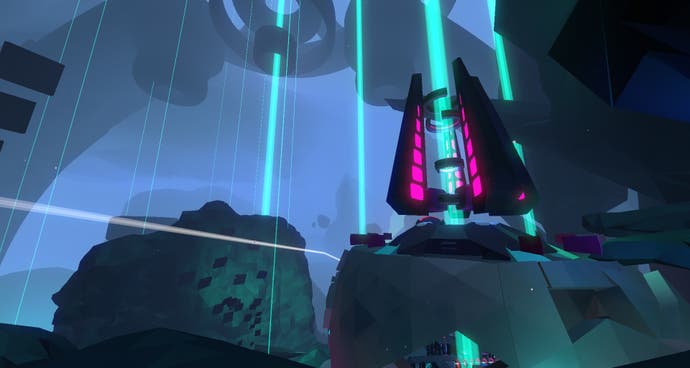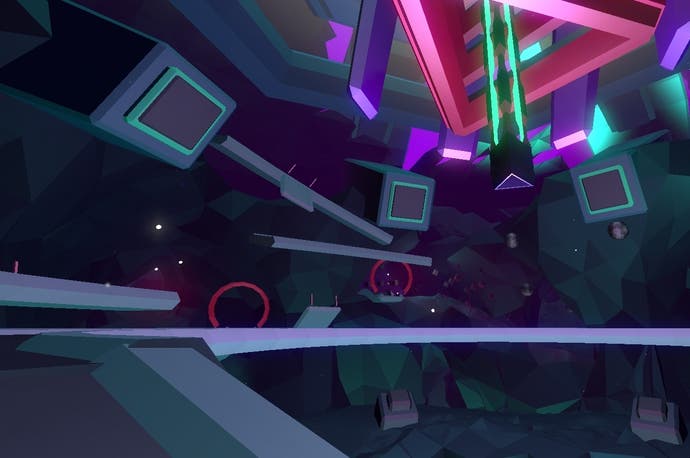Exploring the music of Fract OSC
From the 2011 IGF winner comes a game of rare beauty.
Music can become grounded, plucked out of the air and tied to a place. It can be as recognisable as a landmark, and it can dredge up memory and inspire nostalgia just as easily as a photo. Music can permeate a space, until the sight of it conjures up the tune just as clearly as if it was being played right next to your ear. Fract OSC has a sense of place that is mired in its music, but it's gone a step further and completely erased the lines separating the two.
"I always wanted it to be pretty big in terms of the scale and size of the space." Richard E Flanagan has been making Fract OSC since Fract, the original prototype, won the Student IGF prize in 2011. What was then a sprawling, unfocused expanse of fractured geometry and primary colours has become something altogether more beautiful and evocative. There's more than a little Tron in Fract's visual heritage, filled as it is with giant beams of light lancing the stratosphere, huge monoliths ringed with neon fluorescence and a consistent line of geometry in every piece of architecture.
It's steeped in grandeur, every structure tightly packed to the next so that they loom over you. Or, conversely, they're fixed to the horizon, visible through cave entrances or the openings in the dilapidated buildings that house Fract's puzzles. Everything seems constructed with the sole purpose of making you feel more than a little overwhelmed. Each room and puzzle plugged into a wider picture to act as cogs in some grand machine.
Despite the abstract nature of the world there's history here. Most of the buildings stand proud, but some have fallen; huge struts creating bridges as they collapsed and masonry scattered across the landscape. "In one way or another I've been wanting to make Fract for ten or fifteen years. And it wasn't always going to be a videogame; at one point it was going to be an art installation," reveals Flanagan. His constant revision of the concept and game have had a tangible effect on the world itself; It looks like it's been built and rebuilt over and over again.
Only now it's dormant, and you're there to wake it up. As you wander through Fract, bits and pieces come alive around you; lines of light languish from their sockets to illuminate the way, and giant cubes are linked by shafts as you approach. These reactive elements set the stage for the real meat of Fract; the puzzles.
"We design the puzzles so there is a certain flexibility," Flanagan informs, "so that there is space for creativity, or just how people solve puzzles." As visually striking as Fract is, this is where it truly shines. Instead of presenting a puzzle with a prescribed solution, a good portion instead require something wholly more creative. Clicking the right mouse button traces scan lines over your screen, and also reveals the interactive layer of the world, allowing you to tweak and fiddle with all the meters and buttons you can find. One set of puzzles echoes Pipe Mania, asking you to guide the flow of music and power from one end of a run to another. A second presents you with a grid, asking you to assign notes to let the world play them in sequence. If you get it right, you can progress. If you get it wrong, you reiterate and experiment.
"There's so much to play with here, knobs to twiddle and drums to bang," says Flanagan. "That's what Fract is, for me." There's a spirit of experimentation and discovery that encourages you to try things out, rather than just focus on coming up with the solution. Some puzzles are relatively linear, asking you to move around blocks or channel a stream through a certain path, but they're all musical, and the best of them require you to genuinely compose a bar of music, or come up with a beat that strikes just the right notes at just the right time to power Fract's world and allow you to progress.
Those notes that you construct become refrains that are called back to when you reach certain central points of the world. Create a melody here, and when you're asked to compose something more substantial it'll be available to you then. You're selecting from your own solutions, puzzles feeding into puzzles feeding into puzzles. It's an audible nesting doll, a musical flow chart that has you channelling aural power through the world.
And as the world comes to life around you, it'll keep playing those little tunes that you've composed, so that each area has just as much of an audio design as a visual one. You know that that synth beat is directly sourced from that location, whereas that chiptune melody is coming from the tower you ascended earlier.

All of this feeds down into the studio, where the fruits of your labour manifest in the tools available to you. The more that you do on the surface in Fract's world, the more you're able to tweak and create in the game's studio, a minimalistic take on electronic music making software. It's instantly accessible, allowing you to conjure up melodies and then warp and twist them while you weave in a thumping bass line and the sharp snare of the drum. At the moment it's somewhat divorced from the puzzle game side of Fract, but Flanagan says the idea is to make it far more holistic by release.
The IGF has always shone a spotlight on the esoteric side of indie game development, and as that esoteric end is becoming larger and larger, we're seeing more and more projects emerge that have a stronger sense of theme and place rather than just doing something mechanically interesting. Even among such company, Fract is looking like a game that is even more adapt at skirting the norm, throwing you into a world that is utterly abstract, but aggressively beautiful.
Playing a preview build that features two of the three large, sprawling levels that Fract will ship with, the ease with which you can lose yourself to the pulsing synths and eerie prettiness of the world and its puzzles was more than a little disarming at first. But the more you play, the more you start to understand the rules by which the world works, and how each puzzle feeds into the next, transferring both the melodies you've created and the skills you've cultivated. Despite the abstraction of the world and systems doing a good job of alienating you from the start, it's impossible to describe Fract as anything but an intimate experience.
But by far its greatest achievement is in allowing you the space to bring your imagination into play when it comes to solving puzzles. To have something that not only works to allow you to progress, but also sounds good at the same time, brings a twin satisfaction of rationally solving a challenge, and emotionally composing something. Doubly so when you know that your composition is unique to you. "This is yours," says Flanagan. "That is your solution, your own little piece of music."

